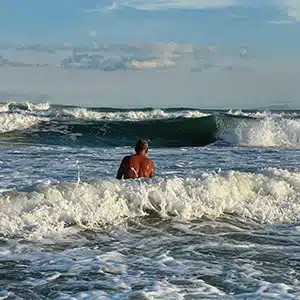
The cover of Mirante, the ninth album from Canadian composer, arranger, and multi-instrumentalist Nick Storring, invokes beauty, sunshine, and a touch of mystery. The photo shows a bronze-skinned man with his back to the camera, wading in the shallow waters of a sunny, choppy ocean. We don’t know who this man is, but the scene is picturesque and inviting. There is no artist or title information on the cover. It appropriately represents what Storring’s Bandcamp page calls an “oblique homage” to Brazil, where the Toronto-based artist has spent much time.
Oblique homages are nothing new for the eclectic Storring; his gorgeous 2020 album My Magic Dreams Have Lost Their Spell was an ambient instrumental tribute to R&B singer-songwriter Roberta Flack, and Storring made it clear that the album’s song titles derive from song lyrics from Flack’s repertoire and that musical resemblances are “purely coincidental” (as he stated on his Bandcamp page). While Mirante seems a bit more directly related to its source of inspiration, it’s still imbued with mystery, even as percussion instruments rattle away in a form of celebration.
Despite the immersive, often dense instrumentation present on Mirante, Storring plays everything. The credits list more than 40 instruments, including a Fender Rhodes, clavinet, bar chimes, dog whistle, singing bowl, talkbox, glockenspiel, and much more. Throughout the record’s seven tracks (spanning 45 minutes), Storring straddles the lines between cerebral ambient and clattering celebration.
Opening with the single “Roxa I”, sparse synthesizer chords ease the listener into the song before the percussion moves in and out, accompanied by gentle melodic runs of keyboard and stringed instruments and ethereal vocalizations. The track often stops and starts without warning, giving it less of a throbbing, dance vibe and more of a reflective one.
“Roxa II” brings the tempo down a bit, adding a moody flavor to the album and invoking some melodic but mercurial “new age” elements. Storring takes his time as the song beautifully unfolds. The title track is a bit of a combination of everything present on the record, bringing together warm chords that sound a bit spacey and alien, but hopeful. The percussion goes into a sort of marching band fervor, and Storring’s love of field recordings and ambient sounds is also thrown in for good measure. At nine minutes and changes, it’s one of the more all-encompassing tracks on the record.
Mirante is nothing if not eclectic. While “Falta De Ar” and “Terra da Garoa” consist almost entirely of chugging, insistent percussion, “Parque Tingui” takes a more ambient approach, as the mysterious buzz and hum of field recordings complement the music’s sustained, minimalist notes. Mirante closes with “Roxa III”, the longest track, which combines reflective, film score-like elements with the ever-present rhythmic ones.
It’s important to emphasize that while Mirante does not come across as an obvious, direct tribute to the sounds of Brazil, it delightfully approaches it from a different angle. It combines the lush soundscapes Storring so often incorporates into his music with the unbridled joy of a rich, dynamic, rhythmic pulse. It’s exotic, thought-provoking, and celebratory, and it is easily one of Nick Storring’s most deeply satisfying and rewarding works to date.

